LI-7820 N2O/H2O Trace Gas Analyzer
Webinar:
Measuring N2O and Other Trace Gases in Soil and Air Using LI-COR Trace Gas Analyzers
From soil flux measurements of N2O and CH4, to point-source detection systems, LI-COR Trace Gas Analyzers are the new standard for portable, precise gas measurements.
Watch the recordingPrecise, stable N2O measurements
The LI-7820 N2O/H2O Trace Gas Analyzer provides consistent, highly precise nitrous oxide measurements. Equipped to traverse the most extreme and remote locations, the analyzer’s compact, portable design coupled with low power requirements allows for easy deployment and data collection.
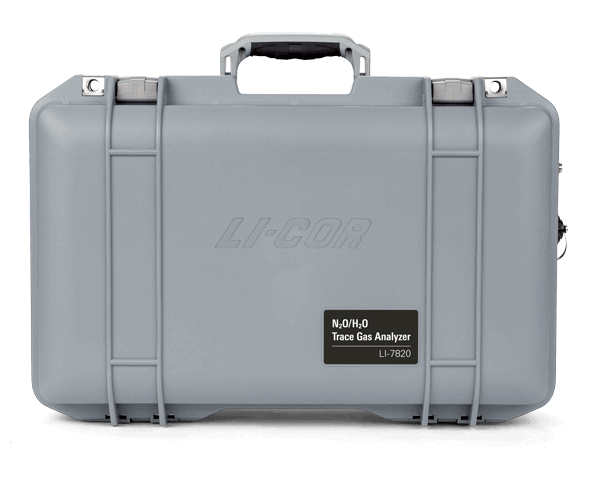
Key specifications
General
- Total Weight: 10.5 kg (including batteries)
- Battery Life: 8 hours typical with 2 batteries
N2O Measurements
-
Response Time (T10-T90): all from 0 to 330 ppb
- ≤ 2 seconds in Standard Configuration
- ≤ 3 seconds in High Altitude Configuration
- Range: 0 to 100 ppm
-
Precision (1σ):
- 0.40 ppb at 330 ppb with 1 second averaging
- 0.20 ppb at 330 ppb with 5 second averaging
- Maximum Drift: < 1 ppb per 24-hour period
Applications
- Soil gas flux measurements
- Atmospheric monitoring
- Urban emissions monitoring
- Mobile emissions monitoring
- Sensor networks
- Large area emissions monitoring
Measuring N2O fluxes in soil
The LI-7820 is ideal for chamber-based measurements in soil gas flux research. The LI-7820 conveniently integrates into both survey and long-term systems, and data can be easily post-processed with SoilFluxPro™ Software. For CH4 and CO2 measurements, pair it with the LI-7810 CH4/CO2/H2O Trace Gas Analyzer. For CO2 measurements alone, pair it with the LI-870 CO2/H2O Analyzer.
For more information on LI-7820 integration with soil gas flux measurements, see the Soil Gas Flux Solutions page.
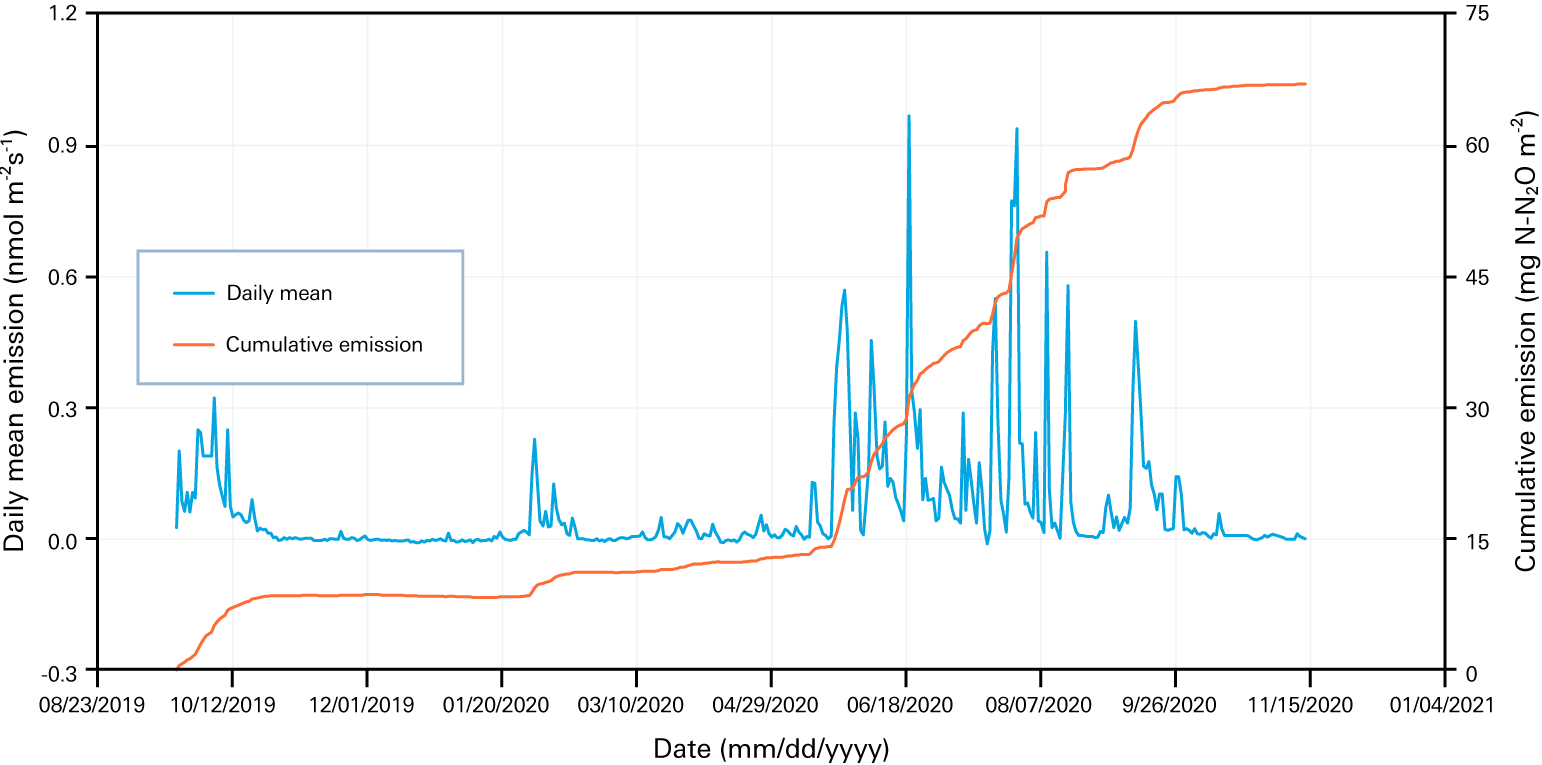
Figure 1. Measurements of N2O flux from soils over a 14-month time period. Measured by the LI-7820 N2O/H2O Trace Gas Analyzer and an LI-8100A Automated Soil CO2 Flux System. Measurements were conducted over an urban lawn in Lincoln, NE, USA, and shows natural variations of N2O fluxes detected by the LI-7820. Results from Xu, et al., 2020.
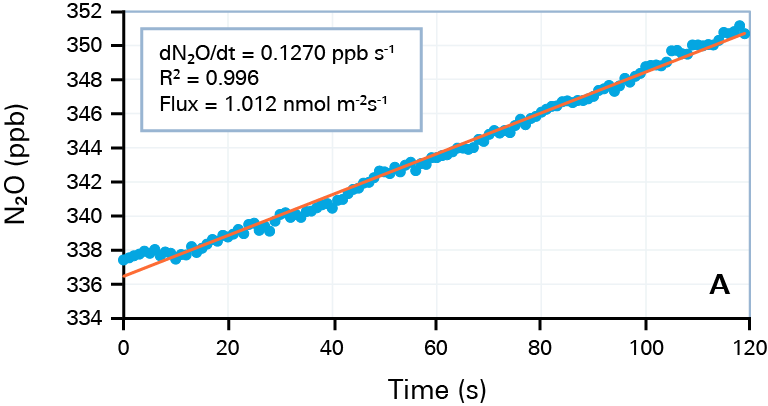
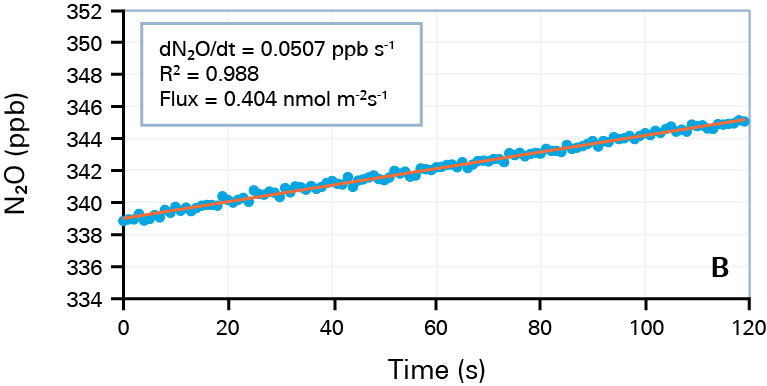
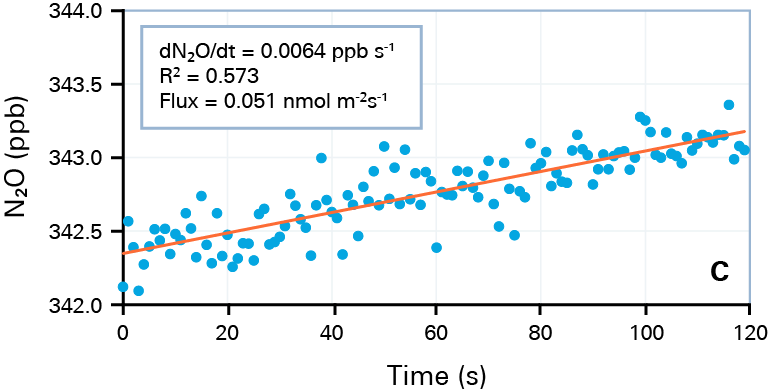
Figure 2. Soil N2O flux measurements with the LI-7820. The precision of the LI-7820 allows fluxes to be resolved within 2 minutes, for both high fluxes (linear regression coefficients higher than 0.9 when N2O flux was higher than 0.1 nmol m-2 s-1, figures A and B), as well as when fluxes from natural emissions occur that can be extremely low. The LI-7820 is capable of measuring flux rates as low as 0.05 nmol m-2 s-1 in 2 minutes under these conditions (C).
When measuring N2O fluxes from soil, fluxes are often minimal and close to zero. There is still natural variation that occurs, which is important to quantify. In order to detect these small, natural variations in soil N2O flux, it is then essential to have an analyzer with high precision that can resolve small fluxes in a timely manner. The precision of the LI-7820 allows you to measure these small variations and resolve natural fluxes of N2O, in addition to being able to measure large fluxes that can occur, for example after a fertilizer treatment.
The example given is from a LI-COR long-term soil flux system. The LI-7820 was used to measure natural fluxes that occur, while also seeing larger fluxes emitted during spring thaw events in Lincoln, Nebraska. Figure 2 provides an example flux calculated in 2 minutes from a closed-chamber measurement.
LI-7820 Specifications
General
- Measurement Technique: OF-CEAS (Optical Feedback – Cavity Enhanced Absorption Spectroscopy)
- Measurement Rate: 1 sample per second (1 Hz)
- Optical Cavity Volume: 6.41 cm3
- Flow Rate:
- 250 sccm nominally in Standard Configuration
- 150 sccm nominally in High Altitude Configuration
- 70 sccm nominally in Reduced Flow Rate Configuration with installed kit
- Total Weight: 10.5 kg (including batteries)
- Case Dimensions: 51 cm × 33 cm × 18 cm (L × W × H)
- Operating Temperature Range: -25 °C to 45 °C (without solar load, under normal operating conditions)
- Operating Humidity Range: 0 to 85% RH (non-condensing, without solar load, under normal operating conditions)
- Sample Line Humidity Range: 0 to 99.9% non-condensing
- Operating Pressure Range:
- 70 to 110 kPa in Standard and Reduced Flow Rate Configurations
- 50 to 110 kPa in High Altitude Configuration
- Connectivity: Ethernet and Wi-Fi (not available in some countries)
- Wi-Fi Compatibility: 2.4 GHz, 802.11 a/b/g/n/ac
- Power Consumption:
- Steady State Operation: 22 Watts at 25 °C without batteries charging
- Warmup: Up to 65 W without batteries charging; up to 100 W with batteries charging
- Off: Up to 2.3 W when powered from pins 3 and 4 without batteries charging; up to 0.2 W when powered from pins 1 and 5 without batteries charging
- Power Supply Requirements:
- Pins 1 and 5 (24 VDC Input): Minimum 6 A at 24 V
- Pins 3 and 4 (10.5 to 33 VDC Input): Minimum 14 A at 10.5 VDC; 6 A at 24 VDC
- Power Supply: Universal Power Adapter (Input: 100 to 240 VAC, 50-60 Hz; Output: 24 VDC)
- Battery Life: 8 hours typical with 2 batteries
- Pollution Degree: 2
- Over-voltage Category: II
- Class 1 Laser Product
N2O Measurements
-
Response Time (T10-T90): all from 0 to 330 ppb
- ≤ 2 seconds in Standard Configuration
- ≤ 3 seconds in High Altitude Configuration
- Range: 0 to 100 ppm
- Precision (1σ):
- 0.40 ppb at 330 ppb with 1 second averaging
- 0.20 ppb at 330 ppb with 5 second averaging
- Maximum Drift: < 1 ppb per 24-hour period
H2O Measurements
- Range: 0 to 60,000 ppm
- Precision (1σ):
- 45 ppm at 10,000 ppm with 1 second averaging
- 20 ppm at 10,000 ppm with 5 second averaging
Specifications subject to change without notice.
Where will your research take you?
Get a QuoteTrace Gas Analyzer Resources
Continue Reading